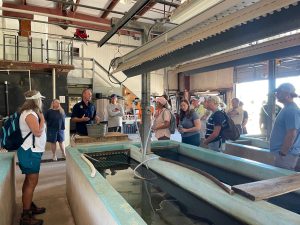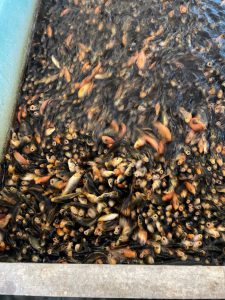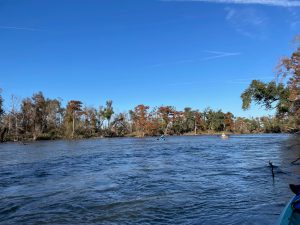
It was built in the late 1930’s by the Works Progress Administration to help starving people survive the Depression. The idea was to create a state-run fish hatchery, insuring fish were healthy at every step from spawn to adult. These fully grown fish, native to the area, would stock local lakes and farm ponds, putting the old “if you teach a man to fish” adage into practice. For 40 years, the fish hatchery in Holt, Florida provided fish for private landowners hoping to stock their ponds. By the 1990’s, though, the practice of using public tax money to provide private citizens with a product had fallen out of favor—particularly with privately run hatcheries that felt it was unfair market competition.

Now, the hatchery staff carries on with the art and science of fish production in much the same way they did decades ago; on a shoestring budget, with a handful of dedicated employees in an open-air concrete building that is too small for their extraordinarily productive work. The Florida Fish & Wildlife Conservation Commission staff currently raise young fish to fingerling or adult size and stock public waterways all over the state. After being grown out in protected concrete raceways, they are relocated to one of several large outdoor ponds. Fish may be shipped (i.e. packed in coolers and driven by a staff member) as far away as the larger hatchery in central Florida, or used to stock rivers and lakes in the Panhandle. Fish species include channel catfish, shoal bass, striped bass, and bream. They also keep a supply of koi fish to use as live bait for the adult “parent” fish kept in house, which provide eggs for the next generation. Annually, the Blackwater Fisheries Research and Development Center (aka Blackwater Hatchery) produces multiple millions of fish.

Hatchery-grown fish were crucial in reviving the decimated shoal bass population for the Chipola River after their natural spawning grounds and habitat were heavily damaged in Hurricane Michael. Local biologists pioneered methods for growing shoal bass in a hatchery environment, adding calcium to increase pH and providing creative habitat structures to mimic conditions in the limestone rock-filled Chipola River.
In addition to the hatchery lab and growing ponds, biologists and technicians with the hatchery maintain nearly 600 acres of land. They use prescribed fire and deliberate removal of certain trees to promote the growth of threatened species like pitcher plants and tiger salamanders. The property, located within Blackwater State Forest, is open to the public and for scheduled tours. It is listed on the Florida Birding Trail, and wildlife is abundant. During our tour this week with Master Naturalist students, we were delighted to see a pair of bald eagles, a whitetail fawn, an alligator, and a little blue heron.
 3
3
